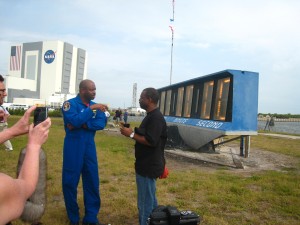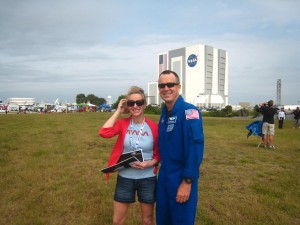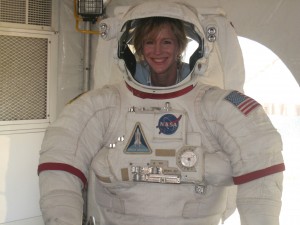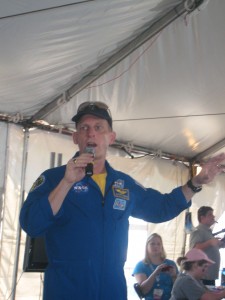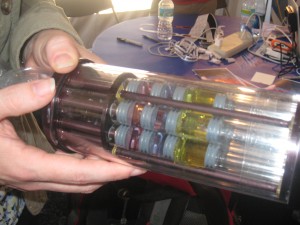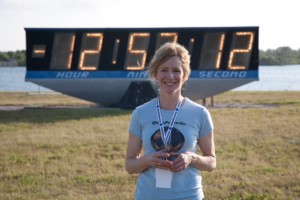Category:The World Around Us’
A Day at the Museum
- by KitchenPantryScientist
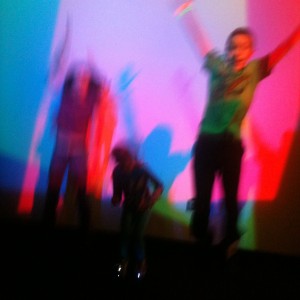 There was no school yesterday, so we went on a field trip of our own to the Science Museum of Minnesota.
There was no school yesterday, so we went on a field trip of our own to the Science Museum of Minnesota.
We started the day by being transported “Under the Sea” at the Omnitheater, watching sea lions frolic and giant sea turtles gobble jellyfish. (Did you know they close their eyes each time they take a bite, so they don’t get stung?) The kids loved “Real Pirates” and filled out activity sheets to win eyepatches. They especially liked playing dice and looking at the different coins in the Treasure Room!
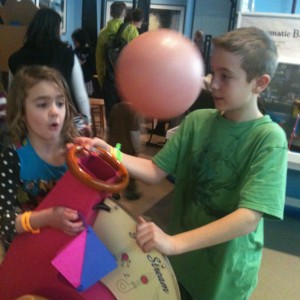
After lunch, they brought some fossils and flint they’d found in Kansas to the Collector’s Corner and then we spent the rest of the day playing at the museum!
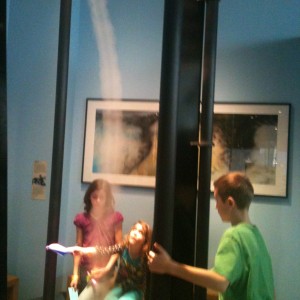
The new wind tunnels, where kids could fashion flying machines from paper, cups and pipe cleaners were a huge hit! I wonder if we could figure out how to make one in our kitchen. Hmmm.
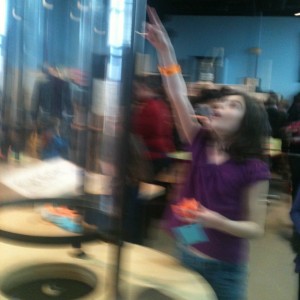
Solar Storms and the Zombie Apocalypse
- by KitchenPantryScientist
My son came home from school the other day joking about a zombie apocalypse. Before that, it was the Mayan apocalypse. And now, he keeps hearing about all these “freaky” solar storms. He laughs, but I’m sure his 11-year-old imagination leaves plenty of room for worry.
I can’t kill the zombies lurking in his subconscience, but I can put his mind (and my own) at ease about the solar storms with this short NASA video that explains that we’re in a totally normal sun cycle and are protected by Earth’s atmosphere
The Science of Success- Mentors
- by KitchenPantryScientist
As I listened to their stories, I couldn’t stop the tears. They were teenagers now, but it was easy to imagine them as 5-year-olds, or 10-year-olds as I watched their awkward gestures, shy eyes and beautiful smiles. I thought of my own children.
These were kids with stories no one wants to hear. Some told of begging for food to feed their younger siblings while their parents, crippled by addiction, traded food stamps for drugs. They told of families struggling with depression, homelessness, suicides, neglect, and abuse. They told stories no child should be telling.
It would be nice to think that they were unusual, but they weren’t. These kids represented some of the 15% of Minnesota kids who live in poverty. And poverty is often associated with conditions that put children’s health and development, education and future job success at risk. It’s a vicious, downward cycle. (And for the record, three-fourths of Minnesota families in poverty have at least one parent in the workforce.)
The kids I heard speaking about their hardships were special though. Although they represented poor, at-risk kids in Minnesota, they had broken the cycle and overcome the hardships of poverty and broken families to succeed in school. They were finalists for the Children’s Defense Fund of Minnesota‘s “Beat the Odds” scholarship. They were moving forward, out of poverty.
And what did they have in common? Each of them had one person in their life who believed in them and told them that they could succeed. Many of them only had one person. One person. That was all it took.
For many, it was a teacher or counselor. For others, it was a sibling, parent or grandparent. But those individuals, those mentors, saved the lives of each of these children in many ways, allowing them to move forward into education, propelling them forward to lead richer lives where day to day existance isn’t a struggle.
Organizations like Children’s Defense Fund help these kids in many ways, fighting for higher minimum wages for the working poor, researching maternal depression and helping poor families get the help they need.
What can you do to help?
Find a way to be a mentor. Many communities organizations and churches have reading-buddy programs and a wealth of other opportunities to help at-risk kids succeed. Tell a child (other than your own) that you believe in them. Tell them that they can be what they want to be. They can do what they want to do. They can succeed.
You might save a life, and in doing so, help build a brighter future for all of us.
Real Pirates and How to Make a Compass
- by KitchenPantryScientist
Last week at the Real Pirates exhibit at the Science Museum of Minnesota, I walked below deck on a mock pirate ship, hoisted a pirate flag (Jolly Roger), touched real pirate treasure and played dice with pirates. The bell of the Whydah, a 300-ton pirate ship greeted us, illuminated by lighting and suspended in a huge tank of water. I could almost imagine it spinning and tumbling to the bottom of the sea off the Massachusetts coast. 146 people aboard the ship drowned when The Wyhdah went down.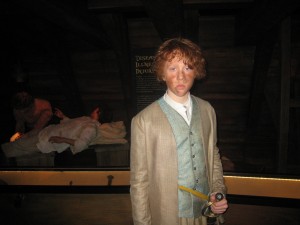
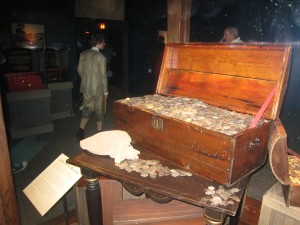
I was lucky enought to meet the treasure hunter-turned-historian Barry Cifford who discovered the wreck of the Whydah. He explained to us that pirate ships were true democracies, where crew mates were equal, no matter their background, age, race or religion. As a result ,many rushed to be pirates- whether they had escaped slavery, unjust society, or were just trying to make their fortune. The captain of the Whydah, Sam Bellamy, needed money to marry the woman he loved. There was even a 10-year old boy named John King aboard the Whydah when she went down…he left his mother to join the pirates. (My 11-year old claims he’d never do that.)
How did pirates navigate their way around the deep blue ocean well enough to ever utter the words “Land Ahoy?” In addition to maps and the stars, they used tools like the ones I saw from the Whydah: sounding weights to determine sea depth and ring dials to tell time. They also used compasses, simple tools for determining which direction North was, even in thick fog. A compass is an instrument containing a magnetized pointer that shows the direction of magnetic north, and you can easily make one with a needle, a magnet and a piece of cork or Styrofoam and a glass bowl (or pie plate) containing a few inches of water.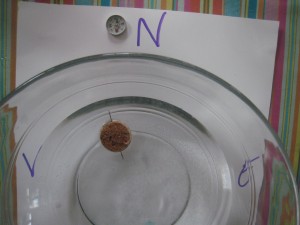 Cut a slice of cork, maybe 1/2 inch thick) with a bread knife (see photo.) Then, magnify the metal in your needle by stroking it from one end to another with a magnet about ten times. (Go the same direction each time.) Push your needle through the cork or Styrofoam and gently set it in the bowl of water. The needle, which you have turned into a magnet, will line up with Earth’s magnetic field, which runs from the South Pole to the North Pole. It should point North and South if you magnetized it correctly!
Cut a slice of cork, maybe 1/2 inch thick) with a bread knife (see photo.) Then, magnify the metal in your needle by stroking it from one end to another with a magnet about ten times. (Go the same direction each time.) Push your needle through the cork or Styrofoam and gently set it in the bowl of water. The needle, which you have turned into a magnet, will line up with Earth’s magnetic field, which runs from the South Pole to the North Pole. It should point North and South if you magnetized it correctly!
Carbon, Bananas, Coal and You
- by KitchenPantryScientist
Earth is like one giant recycling bin.
The energy we get from the sun is constantly renewed, but water and other chemical elements (like carbon and nitrogen) on earth are used over and over again as living things take them in, use them, and then put them back into the environment. These recycling processes are called “biogeochemical cycles” and include the water cycle, the carbon cycle and the nitrogen cycle.
When I was at NASA’s Goddard Space Center, a scientist showed us this video he made about how the carbon cycle works. You can see for yourself how every time you eat a banana or drive a car, you are part of the cycle.
NASA’s Climate Kids website also has some cool explanations of how the carbon cycle works. You can actually blow through a straw into a liquid that is an acid-indicator and watch the liquid become more acidic from the carbon dioxide in your breath! I’m trying to figure out how to make this experiment safe and easy to do at home, and will post it when I figure it out.
En Route to the Space Station
- by KitchenPantryScientist
My sound experiment post will have to wait, because the video NASA is posting from the space shuttle Endeavour is too cool not to share! The video above is from day 2 of the mission as STS-134’s crew travels to the International Space Station.
The astronauts are hard at work, and one of the first things you’ll see is Astronaut Mark Kelly shaking up some plastic cylinders to start a microbiology experiment!!! At the NASA tweetup, we got to see one of these culture tubes close up!

The tube has three compartments: bacteria, liquid food for bacteria, and tiny worms called nematodes that the bacteria can infect! First, they mix the bacteria with the food, then they mix the bacteria with the worms. In space, the bacteria get really “infectious”and “virulent”, and researchers on back earth study them and use the information to make better vaccines to keep people healthy.
Have you ever heard of Salmonella bacteria that can be in eggs and make people sick? This is one of the bacteria they’re studying!
Today, NASA posted this great video of Endeavour “doing a final backflip before docking with the space station.”
Godspeed Endeavour
- by KitchenPantryScientist
Twenty kids stopped eating donuts long enough to shout out a countdown this morning in my living room. We gasped as Endeavour’s rockets blossomed, smiled at the crackle and roar and cheered as she ascended, rolled gracefully and disappeared into the clouds with a flash of orange. We watched in awe as the side booster rockets blew off and the shuttle floated free of the external tank with the curve of the earth in the background. I have to admit that I got a little misty- not because I wasn’t standing at the countdown clock to experience it live, but because despite the laws of physics and all the safety precautions, it still seems like a miracle each time we send people safely into orbit.
NASA and the American Dream
- by KitchenPantryScientist
A recent trip to Kennedy Space Center made me feel like a kid again and I’m reveling in a momentary lapse of cynicism. Please excuse me if I sound cheesy, or over the top, but I haven’t come back down to earth quite yet.
The United States is is a young nation. We have not been afraid to explore, and our boldness led us to take humankind’s first steps on the moon.
Naturally, our curiosity has led us to some dead ends and we’ve taken a few tumbles, but through basic scientific exploration and hard work we have stumbled upon a wealth of information that has made each of our lives better.
Even while being robbed of our innocence, our country has managed to hold strong to the ideals of freedom and equality. Sadly, our childlike wonder has not been so lucky and is in danger of becoming a casualty of the aging process. Gravity pulls us down each time we cut funding to scientific research. It doesn’t hurt much yet, but could bring us to our knees.
At Kennedy Space Center the last week of April, I attended a “tweetup” sponsored by NASA for 150 of it’s Twitter followers. There to witness the launch of space shuttle Endeavour, we were given behind-the-scenes tours at NASA and listened to a number of astronauts, scientists, engineers, and technicians speak about working for the space program. Their passion and conviction for what they do was the most patriotic expression I’ve ever witnessed. The message I heard over and over again was the mantra of the American dream.
“Work hard in school and you can be whatever you want to be.” (Maybe even an astronaut.)
“The best stuff is still in front of us.”
“When we stop exploring we will falter.”
NASA is not about astronauts sitting around eating freeze-dried ice cream. It is about exploration and science. It is about “revealing the unknown about the planet on which we live” and learning about our place in the universe. The astronauts on the space station are conducting experiments which will yield better vaccines and cancer treatments, among other things. They’re gleaning priceless information about our home planet that we simply can’t capture with our feet on the ground.
Of course it is important for us to be fiscally responsible as a nation, but we can’t lose our childlike wonder or we will lose what sets us apart from the rest of the world. We will fail to thrive when we fail to explore and make new discoveries. NASA embodies the American spirit of exploration and symbolizes what makes us so great as a nation.
As NASA’s chief scientist Waleed Abdalati said, there is a “brilliant future ahead that is ours for the creating.”
Astronauts Rock(et)
- by KitchenPantryScientist
We waved and screamed as the Astrovan (carrying the astronaut crew to the shuttle Endeavour) drove past our NASA Tweetup group yesterday. Moments later, our hearts fell when we witnessed the first-ever Astrovan turn-around as the launch was “scrubbed”, or delayed, and the astronauts headed back to quarantine to wait for the next launch attempt. Putting on brave smiles, we trudged back to our tent. Everyone was sad, but one thing we learned at the tweetup is that NASA always puts safety first, and for good reason.
Astronauts. Absolutely nothing comes before astronaut safety. Not a presidential visit, not millions of viewers, not politics…nothing. So, when an Auxiliary Power Unit heater didn’t seem to be working correctly, they delayed the launch. I was astonished at the overwhelming pride and sense of responsiblity that the NASA employees who spoke to us expressed for each mission and every human life that we send into space.
The astronauts who spoke to our group were amazing, accomplished individuals with a unified message: be curious, work hard in school, and follow your dreams. Any kid who wants to be an astronaut has that potential. And parents…it’s our job to fan that creative, imaginative, curious spark in our kids, whether it’s by letting them bang on some pans (Astronaut Leland Melvin) to learn about sound, or simply to encourage them to do something that might seem out of reach. (NASA Astronaut Ricky Arnold is a teacher, not a military man.)
NASA Tweetup -Day 1
- by KitchenPantryScientist
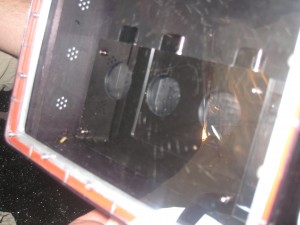
How Golden Orb spiders travel to space
